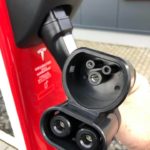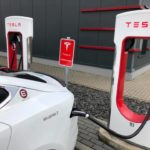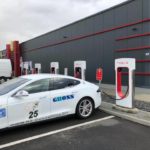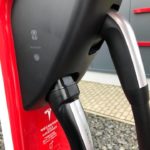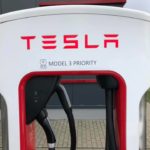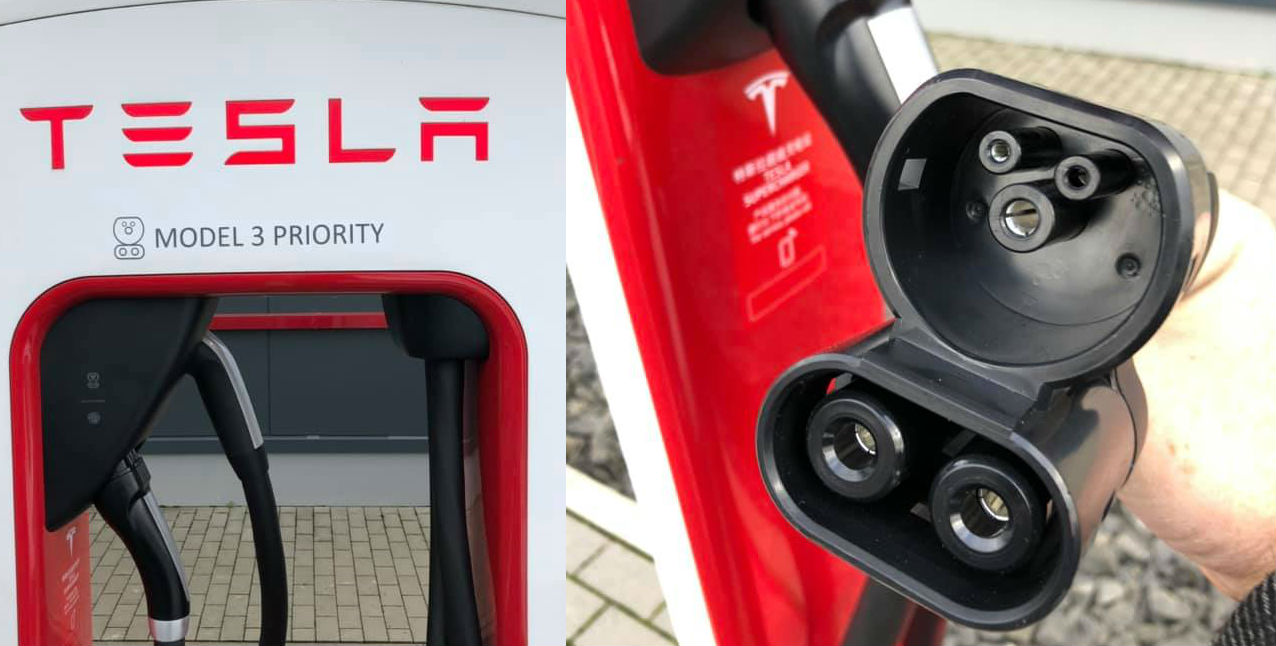
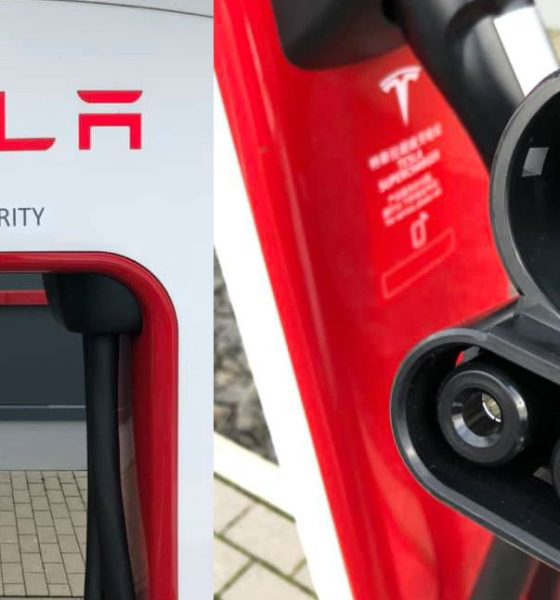
News
Tesla’s CCS Supercharger expansion ramps with dual-charge stall sightings in Europe
Tesla is yet to start deliveries of the Model 3 in Europe, but the electric car maker is already making the necessary preparations for the vehicle’s upcoming arrival. Across the region, for example, Tesla is expanding its CCS Supercharger Network, which is specifically designed to support the Model 3. Several members of the Tesla community across Europe have shared images of the dual charge stations being installed in multiple locations as well, further suggesting that Tesla’s CCS Supercharger ramp is well underway.
As noted by Tesla in a previous statement, the first dual charge CCS charging stalls were set up in the Badhoevedorp Supercharger near the Corendon Village Hotel, just outside Amsterdam last month. Tesla installed eight additional stalls on the site, each one equipped with both a Type 2 and CCS plug. The electric car maker noted that the CCS stalls are compatible with the Model S, 3, and X, though images of the chargers themselves list the stations as “Model 3 Priority.” Tesla further noted that the existing Supercharger Network in Europe would be retrofitted with the dual charge setup in the near future.
In true Tesla fashion, Tesla has not let up on its efforts to expand its CCS Superchargers in the region. Earlier this month, images of the first CCS-compatible Supercharger stall from Norway was shared on Reddit. Tesla owner enthusiast and longtime YouTube host Bjorn Nyland even featured the newly installed dual charge stations in one of his videos. In social media platforms, Tesla owners from Germany have also reported sightings of the newly-updated Superchargers being set up — an indication that Tesla is preparing for a massive influx of Model 3 in the region.
- (Photo: Klaus Schäfer/Facebook)
- (Photo: Klaus Schäfer/Facebook)
- (Photo: Klaus Schäfer/Facebook)
- (Photo: Klaus Schäfer/Facebook)
- (Photo: Klaus Schäfer/Facebook)
A dual charge CCS Supercharger listed as “Model 3 Priority” is spotted in Germany. (Photo: Klaus Schäfer/Facebook)
Unlike the Model S and Model X — both of which are fitted with a Type 2 port — the Model 3 is equipped with a CCS port. The company’s adoption of CCS stands as a significant step forward for the electric car maker, considering that the standard is prevalent in the region, being preferred by notable European automakers such as Volkswagen, BMW, and the Daimler group. CCS combines a Type 2 design, which is utilized for slower AC charging at home or work, as well as two DC pins at the bottom for fast charging. By adopting CCS for the Model 3, Tesla is all but laying the foundations for a massive charging infrastructure that employs one of the most popular standards in the region.
This, of course, presents some advantages for the electric car maker. Considering the wide reach of the Supercharger Network, Tesla could open the doors to its charging infrastructure to other automakers, providing itself with a potentially lucrative source of revenue. This was something that was referenced by Tesla Head of Global Charging Infrastructure Drew Bennett in an interview with Auto Express UK, when he noted that several electric car companies have already reached out to Tesla about the idea of using the Supercharger Network.
“We’re definitely open to talking to other car manufacturers who want to have access to the network. Capacity is a driver for our investment; it’s new routes, new markets and then capacity. A lot of car makers have spoken to us about it, but we haven’t had any conclusive discussions on it. They’re still trying to figure out what they would need in a network, but we’re a couple of years ahead of them in terms of embracing the investment required to transition to EVs,” he said.
As Tesla’s CCS Supercharger ramp continues, thousands of Model 3 are already being shipped to Europe from the United States. Local news reports suggest that Tesla is aiming to ship 3,000 of the vehicles every week for the region. For now, though, there is practically nothing that could stand in the way of the Model 3’s eventual saturation of the European market, especially considering that regulators recently granted homologation approval for the electric sedan.
Watch Bjorn Nyland’s video on Tesla’s CCS Superchargers in the video below.

News
Tesla FSD fleet is nearing 7 billion total miles, including 2.5 billion city miles
As can be seen on Tesla’s official FSD webpage, vehicles equipped with the system have now navigated over 6.99 billion miles.

Tesla’s Full Self-Driving (Supervised) fleet is closing in on almost 7 billion total miles driven, as per data posted by the company on its official FSD webpage.
These figures hint at the massive scale of data fueling Tesla’s rapid FSD improvements, which have been quite notable as of late.
FSD mileage milestones
As can be seen on Tesla’s official FSD webpage, vehicles equipped with the system have now navigated over 6.99 billion miles. Tesla owner and avid FSD tester Whole Mars Catalog also shared a screenshot indicating that from the nearly 7 billion miles traveled by the FSD fleet, more than 2.5 billion miles were driven inside cities.
City miles are particularly valuable for complex urban scenarios like unprotected turns, pedestrian interactions, and traffic lights. This is also the difference-maker for FSD, as only complex solutions, such as Waymo’s self-driving taxis, operate similarly on inner-city streets. And even then, incidents such as the San Francisco blackouts have proven challenging for sensor-rich vehicles like Waymos.
Tesla’s data edge
Tesla has a number of advantages in the autonomous vehicle sector, one of which is the size of its fleet and the number of vehicles training FSD on real-world roads. Tesla’s nearly 7 billion FSD miles then allow the company to roll out updates that make its vehicles behave like they are being driven by experienced drivers, even if they are operating on their own.
So notable are Tesla’s improvements to FSD that NVIDIA Director of Robotics Jim Fan, after experiencing FSD v14, noted that the system is the first AI that passes what he described as a “Physical Turing Test.”
“Despite knowing exactly how robot learning works, I still find it magical watching the steering wheel turn by itself. First it feels surreal, next it becomes routine. Then, like the smartphone, taking it away actively hurts. This is how humanity gets rewired and glued to god-like technologies,” Fan wrote in a post on X.
News
Tesla starts showing how FSD will change lives in Europe
Local officials tested the system on narrow country roads and were impressed by FSD’s smooth, human-like driving, with some calling the service a game-changer for everyday life in areas that are far from urban centers.

Tesla has launched Europe’s first public shuttle service using Full Self-Driving (Supervised) in the rural Eifelkreis Bitburg-Prüm region of Germany, demonstrating how the technology can restore independence and mobility for people who struggle with limited transport options.
Local officials tested the system on narrow country roads and were impressed by FSD’s smooth, human-like driving, with some calling the service a game-changer for everyday life in areas that are far from urban centers.
Officials see real impact on rural residents
Arzfeld Mayor Johannes Kuhl and District Administrator Andreas Kruppert personally tested the Tesla shuttle service. This allowed them to see just how well FSD navigated winding lanes and rural roads confidently. Kruppert said, “Autonomous driving sounds like science fiction to many, but we simply see here that it works totally well in rural regions too.” Kuhl, for his part, also noted that FSD “feels like a very experienced driver.”
The pilot complements the area’s “Citizen Bus” program, which provides on-demand rides for elderly residents who can no longer drive themselves. Tesla Europe shared a video of a demonstration of the service, highlighting how FSD gives people their freedom back, even in places where public transport is not as prevalent.
What the Ministry for Economic Affairs and Transport says
Rhineland-Palatinate’s Minister Daniela Schmitt supported the project, praising the collaboration that made this “first of its kind in Europe” possible. As per the ministry, the rural rollout for the service shows FSD’s potential beyond major cities, and it delivers tangible benefits like grocery runs, doctor visits, and social connections for isolated residents.
“Reliable and flexible mobility is especially vital in rural areas. With the launch of a shuttle service using self-driving vehicles (FSD supervised) by Tesla in the Eifelkreis Bitburg-Prüm, an innovative pilot project is now getting underway that complements local community bus services. It is the first project of its kind in Europe.
“The result is a real gain for rural mobility: greater accessibility, more flexibility and tangible benefits for everyday life. A strong signal for innovation, cooperation and future-oriented mobility beyond urban centers,” the ministry wrote in a LinkedIn post.
News
Tesla China quietly posts Robotaxi-related job listing
Tesla China is currently seeking a Low Voltage Electrical Engineer to work on circuit board design for the company’s autonomous vehicles.

Tesla has posted a new job listing in Shanghai explicitly tied to its Robotaxi program, fueling speculation that the company is preparing to launch its dedicated autonomous ride-hailing service in China.
As noted in the listing, Tesla China is currently seeking a Low Voltage Electrical Engineer to work on circuit board design for the company’s autonomous vehicles.
Robotaxi-specific role
The listing, which was shared on social media platform X by industry watcher @tslaming, suggested that Tesla China is looking to fill the role urgently. The job listing itself specifically mentions that the person hired for the role will be working on the Low Voltage Hardware team, which would design the circuit boards that would serve as the nervous system of the Robotaxi.
Key tasks for the role, as indicated in the job listing, include collaboration with PCB layout, firmware, mechanical, program management, and validation teams, among other responsibilities. The role is based in Shanghai.
China Robotaxi launch
China represents a massive potential market for robotaxis, with its dense urban centers and supportive policies in select cities. Tesla has limited permission to roll out FSD in the country, though despite this, its vehicles have been hailed as among the best in the market when it comes to autonomous features. So far, at least, it appears that China supports Tesla’s FSD and Robotaxi rollout.
This was hinted at in November, when Tesla brought the Cybercab to the 8th China International Import Expo (CIIE) in Shanghai, marking the first time that the autonomous two-seater was brought to the Asia-Pacific region. The vehicle, despite not having a release date in China, received a significant amount of interest among the event’s attendees.
